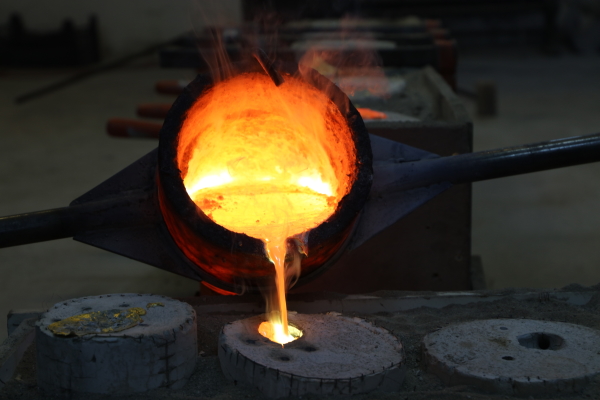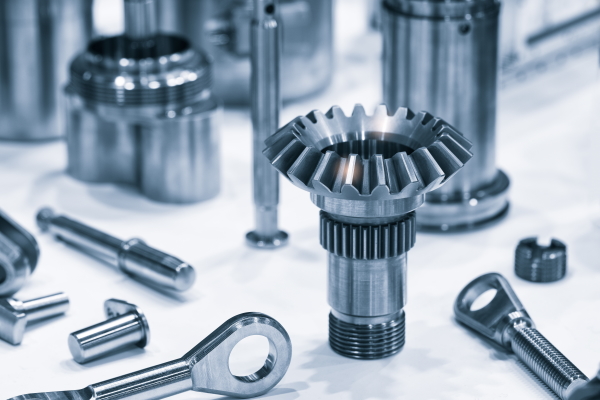What are metals?
Metals are a group of chemical elements that are usually shiny, solid, and good conductors of heat and electricity. They have a high density and are usually malleable.
Metal atoms are arranged in a lattice-like structure (metal lattice). In contrast to salts (ionic lattice), only the atomic nuclei and the inner electrons are arranged in a lattice-like structure in metals. The outer electrons form a free-moving electron cloud that whirls between the atomic nuclei. Just as ionic bonds hold the lattice together in salts, very strong forces hold the lattice together in metals. These forces act between the positively charged atomic nuclei (atomic trunks) and the electron cloud and are called metal bonds.
Metals play an important role in many aspects of daily life, from the manufacture of tools and machinery to electronics and jewelry making. Chemically, metals consist of positively charged atomic nuclei called cations surrounded by freely moving electrons. These electrons are responsible for the conductivity of metals. Metals often react with acids, releasing hydrogen gas, and can also react with oxygen, resulting in corrosion.
There are many different metals, including iron, copper, aluminum, and gold, each with its own unique chemical properties.
When did man discover metals for himself?
The history of man's use of metals is one of discovery, innovation and technological advancement. Metals have played a major role in shaping our civilization and are still essential to many aspects of our daily lives.

Fig.1.: Melting and shaping metal
Man's use of metals goes back a long way:
- copper age: The use of metals began about 10,000 years ago in the so-called copper age. People discovered that copper occurs in pure form in nature and it can be made into various shapes by melting and casting. Copper was used for tools, weapons and jewelry and was an important step in the development of human society.
- Bronze Age: Around 3000 BC, the Bronze Age began, when people started to make bronze. Bronze is an alloy of copper and tin and was ideal for tools, weapons and armor because of its hardness and durability. The use of bronze had a great impact on the development of cultures and enabled advances in agriculture, trade and warfare.
- Iron Age: The Iron Age began around the 12th century BC and marked another important milestone in the history of metal use. Iron is the most common metal on Earth, but it is more difficult to extract and process than copper or bronze. The discovery of iron processing enabled the construction of tools, weapons, and machines that greatly increased human productivity and efficiency.
- Industrial Revolution: The Industrial Revolution in the 18th and 19th centuries brought tremendous progress in metal processing and use. The development of steam engines and the introduction of coal as a source of energy enabled the mass production of iron and steel. This led to tremendous growth in industry and infrastructure, including railroads, bridges, and buildings.
- Modern Era: In modern times, the use of metals has continued to grow and expand to a variety of applications. Metals such as aluminum, titanium and stainless steel are used in aerospace, construction, electronics, medicine and many other industries.
What are the uses of metals in modern society?
Everyday Applications
Metals are found in many everyday utensils and products. From cutlery and cookware to electronics such as cell phones and laptops to vehicles and buildings, metals are used to increase the strength, durability and reliability of items.
Medical applications
Metals such as titanium and stainless steel are used in medical devices for implants, prosthetics and medical instruments. They are biocompatible, durable and corrosion resistant, making them ideal for use in the human body.
Electronics and communications
Circuit boards, microchips and cables are made of metals such as copper, silver and gold. These metals enable the transmission of electrical current and the storage of information.
Power generation
Metals are needed for the production of solar cells, wind turbines and batteries. Copper and aluminum, for example, are good conductors and enable the efficient conversion and storage of energy.
Infrastructure and construction
Steel is a metal alloy and is used to construct bridges, buildings, roads and other infrastructure projects. It is durable and can withstand large loads.
Transportation
Vehicles such as cars, trains, planes and ships are made of metals. They give them the strength and stability necessary to meet the demands of transportation and to span great distances.

Fig.2.: Metal components
What place do metals have in industry?
Metals play a crucial role in the manufacturing industry and are of great importance from a chemical point of view. Not only are they present in numerous products, but they also serve as important catalysts and enable chemical reactions that are essential for the production of many materials.
Why are metals so important in the manufacturing industry? It's because of their unique chemical properties. Metals are typically good conductors of heat and electricity, making them ideal for use in electronic devices and wiring. They can be formed into a variety of shapes, making them a versatile material for manufacturing products. Many metals are stable and corrosion resistant, which allows them to retain their properties even under extreme conditions. This is especially important in industries such as automotive and aerospace, where product safety and reliability are paramount.
Metals act as catalysts. Catalysts are substances that accelerate chemical reactions without being consumed themselves. Metals such as platinum, palladium and rhodium are known for their catalytic properties and are used in many industrial processes. In the chemical industry, they can be used to produce plastics, pharmaceuticals and other chemical compounds.
Metals also play an important role in environmental technology, as they are used in exhaust gas purification systems to reduce harmful emissions. Catalysts made of metals can convert toxic gases such as nitrogen oxides into more harmless compounds. This is an important contribution to reducing environmental pollution and protecting people's health.
Conclusion: Metal has a high economic importance
In addition to their chemical importance, metals also have an economic impact. The manufacturing industry is an important economic sector that creates jobs and contributes to economic development. Because metals are an essential component of many products, modern industry would be unthinkable - the needs of our society today could not be met. Therefore, it is important to ensure the availability and sustainability of metals to ensure the future of the manufacturing industry.
 www.donauchem.at
Related sources:
https://studyflix.de/chemie/metalle-und-nichtmetalle-5038
www.donauchem.at
Related sources:
https://studyflix.de/chemie/metalle-und-nichtmetalle-5038 - as of 03.07.2023